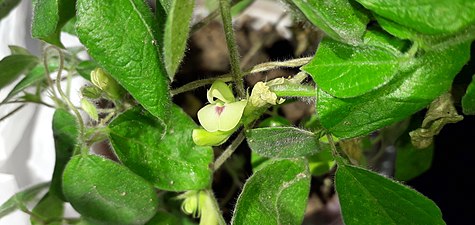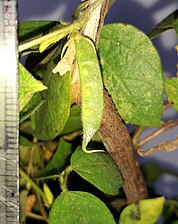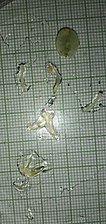User:Creativecrop/sandbox
| Creativecrop/sandbox | |
|---|---|

| |
| Horse gram seeds | |
| Scientific classification | |
| Kingdom: | Plantae |
| Clade: | Tracheophytes |
| Clade: | Angiosperms |
| Clade: | Eudicots |
| Clade: | Rosids |
| Order: | Fabales |
| Family: | Fabaceae |
| Subfamily: | Faboideae |
| Genus: | Macrotyloma |
| Species: | M. uniflorum
|
| Binomial name | |
| Macrotyloma uniflorum | |
| Varieties | |
| |
| Synonyms[1] | |
| |
Macrotyloma uniflorum (horsegram, also known as horse gram, kulthi bean, gahat, hurali, or Madras gram
Description
Macrotyloma uniflorum is a perennial climbing plant with a rhizome, growing to a height of about 60 cm (24 in). The stem sprouts from the rhizome each year. It is clad in varying amounts of whitish hairs and bears alternate, trifoliate leaves with petioles up to 7 cm (2.8 in) long. The leaflets are obovate or elliptical, and up to 7 cm (2.8 in) long. The flowers are borne in twos or threes in the leaf axils, and are typical of the bean family with banner, wings and keel. They are cream, yellowish or green, often with a purple blotch inside. These are followed by linear-oblong, upcurving pods up to 8 cm (3.1 in) long, containing up to ten reddish-brown, speckled or black seeds.[4]
-
Young plant
-
Flowers
-
Young fruit
-
Dissection of floral parts
Distribution
Horse gram is native to tropical southern Asia and has been found in archaeological sites in India, starting from 2500 BC.[5] The plant was probably first domesticated in India, and is now grown as a legume from India to Myanmar. Additionally, the crop is also grown for fodder and green manure in tropical countries in southeastern Asia, and in northern Australia.[4] Generally, the major growing areas of Macrotyloma uniflorum are located in India, Africa and Australia. [6]
Cultivation
Horse gram is drought tolerant [7] and also stands harsh environmental conditions such as salinity or metal stresses [8]. Generally, Horse Gram is planted with low agronomic inputs and without weeding. Furthermore, the crop grows on a broad range of soil types with different pH ranges. Cultivation is also possible on soils with poor organic matter and nitrogen availability. [9] Horse gram thrives where the temperature is in the range of 20 to 30 °C (68 to 86 °F). Frost tempratures are lethal. [6] Due to the drought-resistance Macrotyloma uniflorum is grown in areas with low precipitation (300–900 mm (12–35 in)). In wetter areas, Horse gram is usually sown at the end of the rainy season to still facilitate cultivation. Nonetheless, Macrotyloma uniflorum does not tolerate waterlogging. [10]
The plant is often cultivated as an inter- or mixed crop together with
Pests
The most important yield-impacting dieseases are
Nutrition
Horse gram and
Horse gram seed contains carbohydrate (57.2% w/w), protein (22% w/w), dietary fiber (5.3% w/w), fat (0.50% w/w), calcium (287 mg), phosphorus (311 mg), iron (6.77 mg) and calories (321 kcal) as well as vitamins like thiamine (0.4 mg), riboflavin (0.2 mg) and niacin (1.5 mg) per 100 grams of dry matter. Its nutritional content is partly dependent on soil conditions and the weather. Its less appealing taste has led it to be not commonly eaten.[13]
The carbohydrate-fraction of horse gram flour consists of
Breeding
Southwest India and Africa are regarded as horse gram
A large amount of
<ref> tag has too many names (see the help page).. Many unfavorable traits such as late flowering, indeterminate twining growth habit, long and thin stem, thermo- and photosensitivity and a poor harvest index exist in horse gram [6]. The digestability and processability improvements described in Nutrition section implicitly suggest to consider the reduction of phytic acid content, tanninsMedicinal uses
Scientists from the
Indian regional specifics
In India, it is also known as ulavalu, gahat, muthira, kulath, or kulthi. It is used to make popular dishes like Kulitan Saaru, Kulitan Upkari, Kulitan Ghassi (coconut curry preparation), and an idli-like preparation (but not fermented) called Kulitan Sannan.
- In Telangana and Andhra Pradesh, horse gram is prescribed for jaundice or as a diuretic, and as part of a weight-loss diet.[citation needed] It is considered helpful for iron deficiencies. Ulavacharu (horse gram soup) is popular dish in Telangana, Andhra Pradesh, it is served with cooked rice in some of the Telugu-speaking people's weddings and ceremonies.
- In kidney stonesin the belief that this dissolves the crystals. Gahat's use is specially reserved for the cold winters, when its heat-producing properties are most useful.
- In Kerala, horse gram, (called മുതിര (muthira) in Malayalam which almost sounds like കുതിര (kuthira), Malayalam word for horse), is used in special kinds of dishes.
- In Tamil Nadu, horse gram (called கொள்ளு - 'kollu' in northern districts and காணம் - 'kaanam' in southern districts ) is commonly used in Tamil dishes, including kollu chutney, kollu porial, kollu avial, kollu sambar, and kollu rasam.
- In Maharashtra and Goa, horse gram (called हुलगा) (hulage/hulaga/kulith in Marathi and kulith in Konkani) is often used to make aamati, kulith usal, pithla and shengule/shevanti.
- In Karnataka cuisine, ಹುರಳಿಸಾರು (hurali saaru), ಹುರಳಿ (hurali) is a main ingredient. Hurali is also used in preparations such as usali, chutney, bassaru, and upsaaru or upinsaru (particularly in the Old Mysore Regions Mandya and Chamrajnagara Districts).
- In South Canara region of Karnataka, in Tulu, it is also called kudu (ಕುಡು).
- In Odisha it is known by the name କୋଳଥ (Kolatha).
- Gahat or kulath is a major ingredient in the food of Pahari region of northern India.
- In Kumaonis. In Garhwal region, another more elaborate dish is phanu which is made in a kadhai with roughly ground gahat (previously soaked overnight) boiled over several hours. Towards the end, some finely chopped greens (palak or spinach, rai, tender radish leaves, or dhania (coriander leaves) if nothing else is available) are added to complete the dish. Served with boiled rice, jhangora (a millet-like grain, used as a staple by poorer Garhwalis only a decade ago and now a prized health-food).
In Myanmar (Burma), horse gram is known as pe bazat (ပဲပိစပ်) in Burmese. It is commonly used in making pon ye gyi, a fermented bean paste used in traditional Burmese cuisine.
References
- ^ "Macrotyloma uniflorum (Lam.) Verdc". Plants of the World Online. Board of Trustees of the Royal Botanic Gardens, Kew. 2017. Retrieved 17 July 2020.
- ^ "Taxonomy - GRIN-Global Web v 1.10.5.0". npgsweb.ars-grin.gov. Retrieved 24 September 2019.
- ^ "Horse Gram" (PDF). Government of India, Directorate of Pulses Development. 3 April 2017.
- ^ ISBN 978-90-5782-170-7.
- ISBN 0415927463.
- ^ a b c d e f g h i Aditya, J. P.; Bhartiya, Anuradha; Chahota, Rakesh K.; Joshi, Dinesh; Chandra, Nirmal; Kant, Lakshmi; Pattanayak, Arunava (1 September 2019). "Ancient orphan legume horse gram: a potential food and forage crop of future". Planta. 250 (3): 891–909. doi:https://doi.org/10.1007/s00425-019-03184-5. Cite error: The named reference "Aditya2019" was defined multiple times with different content (see the help page).
- ^ Bhardwaj, Jyoti; Chauhan, Rohit; Swarnkar, Mohit Kumar; Chahota, Rakesh Kumar; Singh, Anil Kumar; Shankar, Ravi; Yadav, Sudesh Kumar (23 September 2013). "Comprehensive transcriptomic study on horse gram (Macrotyloma uniflorum): De novo assembly, functional characterization and comparative analysis in relation to drought stress". BMC Genomics. 14 (1): 647. doi:https://doi.org/10.1186/1471-2164-14-647.
- ^ a b Prasad, Saroj Kumar; Singh, Manoj Kumar (1 May 2015). "Horse gram- an underutilized nutraceutical pulse crop: a review". Journal of Food Science and Technology. 52 (5): 2489–2499. doi:https://doi.org/10.1007/s13197-014-1312-z.
- ^ a b c d Kumar D (2007) Production technology for horse gram in India, Central Arid Zone Research Institute. Evergreen Printers, Jodhpur, India, pp 1–27, http://www.cazri.res.in/publications/KrishiKosh/113-(PRODUCTION%20TECHNOGY%20).pdf
- ^ Brink, Martin (2006). Cereals and Pulses. https://books.google.ch/books?id=dH6S9MwTupUC&pg=PA102&redir_esc=y#v=onepage&q&f=false PROTA. pp. 102–104. ISBN 978-90-5782-170-7
- ^ Haq Nazmul (2011) Underutilized food legumes: potential for multipurpose uses. In: Pratap A, Kumar J (eds) Biology and breeding of food legumes. CAB International, UK, pp 335–336
- ^ Kadam, S. S., & Salunkhe, D. K. (1985). Nutritional composition, processing, and utilization of horse gram and moth bean. Critical reviews in food science and nutrition, 22(1), 1–26. https://doi.org/10.1080/10408398509527416
- ISSN 1018-7081.
- ^ Sreerama, Y. N., Sasikala, V. B., & Pratape, V. M. (2008). Nutritional implications and flour functionality of popped/expanded horse gram. Food chemistry, 108(3), 891–899. https://doi.org/10.1016/j.foodchem.2007.11.055
- ^ a b Chahota, Rakesh & Thakur, Nisha & Sharma, Reecha. (2020). Efficient Improvement in an Orphan Legume: Horsegram, Macrotyloma uniflorum (Lam.) Verdi, Using Conventional and Molecular Approaches. 10.1007/978-3-030-47306-8_12. }
- ^ Mallikarjun, Y. (April 25, 2013). "Raw horse gram good for diabetics". The Hindu. Retrieved May 31, 2017.
External links
- Fuller, D.Q. & Murphy, C. (2018). "The origins and early dispersal of horsegram (Macrotyloma uniflorum), a major crop of ancient India". S2CID 9543710.)
{{cite journal}}: CS1 maint: multiple names: authors list (link
- Kadam SS, Salunkhe DK (1985). "Nutritional composition, processing, and utilization of horse gram and moth bean". PMID 3899515.
Category:Phaseoleae Category:Edible legumes Category:Taxa named by Jean-Baptiste Lamarck





